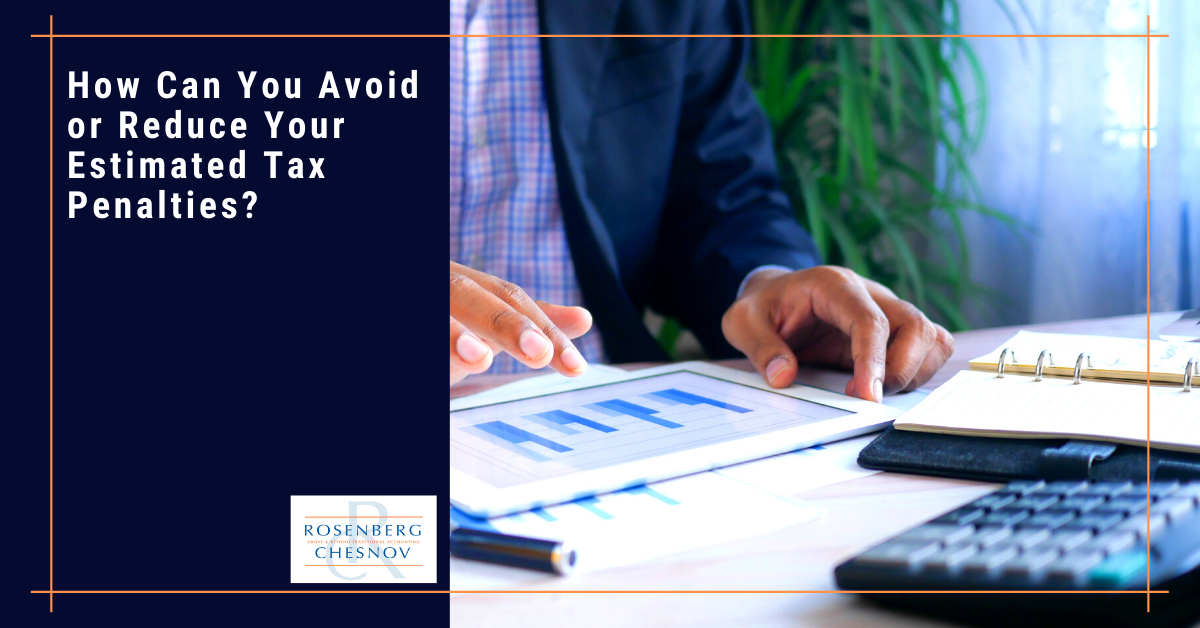What is estimated tax?
The United States tax system is “pay-as-you-go.”
What does that mean?
It means that although many taxpayers only have to think about their taxes once per year, when they file their returns, they pay most of what they owe throughout the year as they earn income.
This happens in either of two ways.
The first way is employer withholding when an employer withholds income tax from an employee’s pay (or from other income such as IRAs, pensions, bonuses, commissions, and gambling winnings).
The second way to pay your taxes as you go is to pay directly to the government through estimated tax payments which you make quarterly throughout the year.
This method applies to income that is not subject to automatic withholding, such as income from self-employment, interest, dividends, alimony, rentals, capital gains from the sale of assets, prizes, and awards. Estimated tax pays not only income tax but also self-employment tax and alternative minimum tax.
To put it more simply: Taxpayers with income not automatically taxed through withholding must make quarterly filings to pay an estimate of the amount they expect to owe for that period. Then, as usual, the taxpayer files their annual tax return once a year and either pays the balance they still owe or requests reimbursement for an overpayment.
If you do not pay enough in estimated tax, or if your payments are late, the IRS may charge you a penalty—even if they owe you a refund on your annual return.
How do I know if I must pay the estimated tax?
As previously mentioned, if your income is not subject to employer withholding, you likely need to make estimated tax payments.
This includes people who are self-employed or are independent contractors.
If you are filing as a sole proprietor, partner, or S corporation shareholder and expect to owe $1,000 or more in taxes when you file your return, you will generally have to make estimated tax payments.
The estimated tax also applies to other types of taxpayers. For example:
- Investors who receive dividends or capital gains income.
- Bondholders who receive interest income.
- Writers who earn royalties.
- Landlords with rental income.
- Taxpayers with more than one job do not have each employer withhold taxes.
- Someone who is a representative of a direct-sales or in-home-sales company.
- Participants in sharing economy activities that are not working as employees.
You may also have to pay an estimated tax if the amount of income tax being withheld from your salary, pension, or other income is not enough. If your employer did not withhold enough tax from your paychecks in the prior year, you might also need to pay the estimated tax in the current year.
Finally, you may also need to make estimated quarterly payments if you have received income from taxable unemployment compensation, retirement benefits, or taxable Social Security benefits.
As a general rule, you likely need to pay estimated tax for the current year if both of the following apply:
- You expect to owe at least $1,000 in tax for the current year, after subtracting withholding and refundable credits.
- You expect your withholding and refundable credits to be less than the smaller of the following:
-
- 90% of the tax to be shown on your current year’s tax return.
- 100% of the tax shown on your previous year’s tax return if your last year’s return covered all 12 months.
The percentage amounts above may differ if you are a farmer, fisherman, or your income is more than $150,000 ($75,000 if Married Filing Separately).
Who does not need to pay estimated tax?
If you do not fall into one of the categories listed above, you most likely do not need to make estimated tax payments. Furthermore, the IRS does not require you to pay estimated taxes if all three of the following conditions apply:
- You were a U.S. citizen or resident alien for the previous full tax year.
- You had no tax liability at all for the previous full tax year (meaning your total tax was zero, or you were not required to file a tax return).
- Your previous tax year covered a twelve-month period.
Broadly speaking, if you don’t have any untaxed income, you most likely don’t have to worry about paying estimated taxes.
How can I avoid or reduce estimated tax penalties?
The best way to avoid penalties entirely is simple: Pay the right amount, and pay on time!
Quarterly payment dates are as follows:
| Payment Period | Due Date |
| January 1 – March 31 | April 15 |
| April 1 – May 31 | June 15 |
| June 1 – August 31 | September 15 |
| September 1 – December 31 | January 15 of the following year. |
| Fiscal-Year Taxpayers | If your tax year doesn’t begin on January 1, see the special rules for fiscal year taxpayers in Chapter 2 of Publication 505 |
| Farmers and Fishermen | See Chapter 2 of Publication 505 |
Of course, estimating your tax liability with perfect accuracy isn’t always easy, especially if your income changes year-to-year or if you gain income from unpredictable sources, such as stocks. One way around this is to take your total tax liability from last year (the amount owed, not the amount paid) and divide it into four quarterly payments. If it turns out you have overpaid, the IRS will reimburse you, and you will have avoided facing any penalties provided you made your payments on time.
One caveat: if you have a higher adjusted gross income (AGIs) of over $150,000, you’ll need to pay 110%, not 100%, of last year’s total tax liability to avoid a penalty.
The IRS also allows you to annualize your estimated tax payments. This can be useful for taxpayers whose income varies significantly throughout the year, such as someone who does most of their work seasonally. However, annualized payments require more work on the taxpayer’s part and better record-keeping.
Finally, if you have one job where your employer withholds your taxes and another income that is not subject to withholding, you can file a new W-4 with your employer to have them withhold more taxes from your earnings to compensate for the other income source. By entering the additional amount you want your employer to withhold, you can skirt paying the estimated tax entirely.
How do I calculate my estimated tax?
Individuals, including sole proprietors, partners, and S corporation shareholders, can calculate their estimated tax using the worksheet in Form 1040-ES. To use this worksheet, you’ll need to know your expected AGI, taxable income, taxes, deductions, and credits for the year. Estimating your payment as accurately as you can also help avoid penalties.
Corporations generally use Form 1120-W to calculate their estimated tax.
Would you like some help?
If you are a client and would like to book a consultation, call us at +1 (212) 382-3939 or contact us here to set up a time.
If you aren’t a client, why not? We can take care of your accounting, bookkeeping, tax, and CFO needs so that you don’t have to worry about any of them. Interested? Contact us here to set up a no-obligation consultation.
Stay informed
Interested in receiving updates in your mailbox? Check out our newsletter, full of information you can use. It comes out once every two weeks, and you can register for it below.





